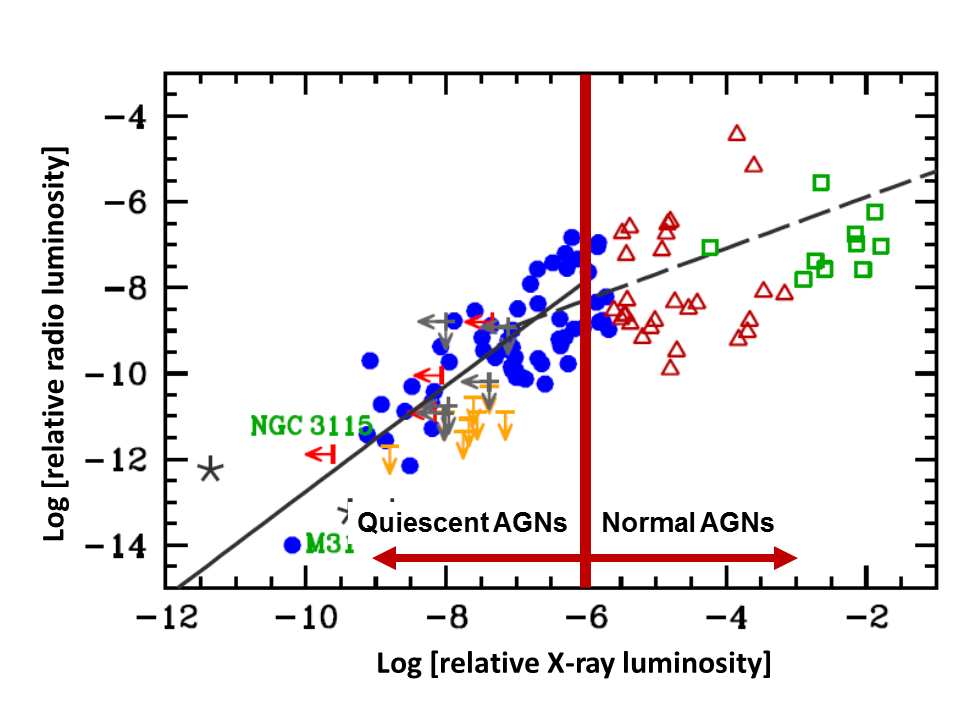Active galactic nuclei (AGNs) and black hole X-ray binaries (BHBs) are the key directions in high-energy astrophysics. It is found that the black hole mass, X-ray luminosity and radio luminosity follow a simple and linear relationship in logarithmic space (see Fig. 1). This tight correlation, known as the “fundamental plane” of black hole activity, plays an important role in numerous research fields, such as the AGN feedback and the formation of relativistic jets.
Like human beings, black holes are the power sources in AGNs and BHBs, through eating (accreting) surrounding matter. Interestingly, most of the black holes in the galaxies of local universe are in a state of starvation, i.e. the nuclei of these galaxies are extremely inactive and they are classified as quiescent AGNs. In the fundamental plane research, one key problem is, whether or not the quiescent AGNs follow the same fundamental plane as that of normal ones. Recently researchers from Shanghai Astronomical observatory (SHAO), XIE Fu-Guo and YUAN Feng, addressed this issue and achieved new progress. Their answer to this problem is that, the quiescent AGNs follow a different radio/X-ray correlation (thus a different fundamental plane) from that of normal AGNs. They further propose to investigate the fundamental plane under a revised parameter space. This work has been published recently in The Astrophysical Journal.

Fig. 1 Fundamental plane of black hole activity in AGNs. (Image by XIE)
This work is based on the largest quiescent AGN sample to date, which includes 75 sources. “Through a Bayesian Monte Carlo simulation approach, based on a much larger sample size, we confirm a previous result that quiescent AGNs are different from normal ones, i.e. they follow a much steeper correlation between radio and X-rays.”, said XIE Fu-Guo.
“Based on this, we argue that, in order to understand the fundamental plane more physically, the fundamental plane should be investigated under a revised parameter space, i.e. the impact of black hole mass on the luminosities should be properly taken into account in advance.” XIE Fu-Guo further explains that, the new parameter space will benefit in dividing/separating different accretion modes (which normally corresponds to different relative luminosities).
What is the physical reason for the quiescent AGNs to follow a steeper radio/X-ray correlation? To this question, Prof. YUAN Feng explains, “whether or not there is a turnover in the radio/X-ray correlation, and where the turnover happens in relative luminosity, are of crucial importance theoretically. They will help us to understand the origin of X-ray emission in these quiescent AGNs. For example, theoretically it is argued that, the X-ray emission of quiescent AGNs is from relativistic jet, while that of normal AGNs comes from the hot accretion flow.
Link to the research paper:
http://iopscience.iop.org/article/10.3847/1538-4357/aa5b90
Science Contacts:
XIE Fu-Guo, Shanghai Astronomical Observatory, fgxie@shao.ac.cn
YUAN Feng, Shanghai Astronomical Observatory, fyuan@shao.ac.cn
News Contact:
ZUO Wenwen, Shanghai Astronomical Observatory, wenwenzuo@shao.ac.cn